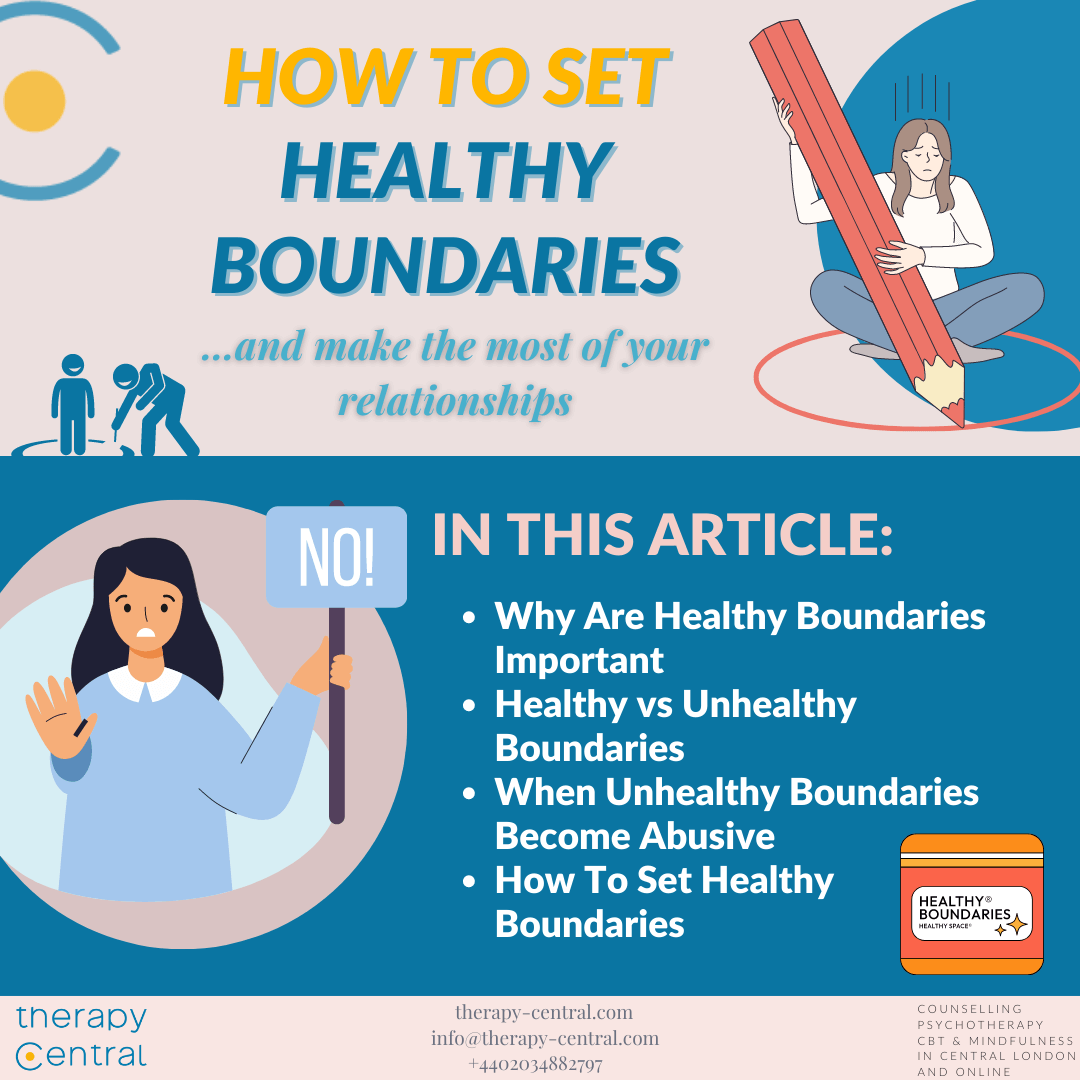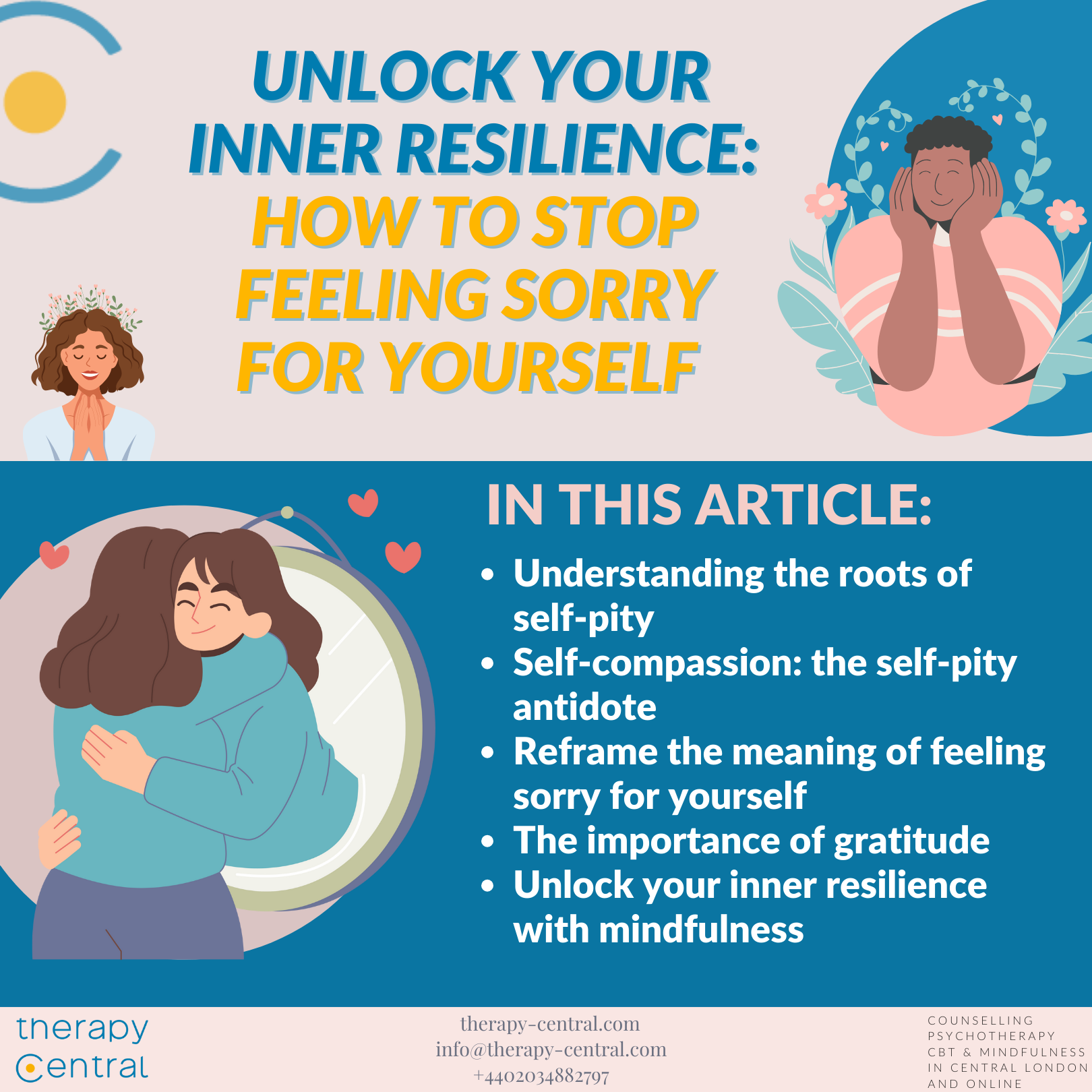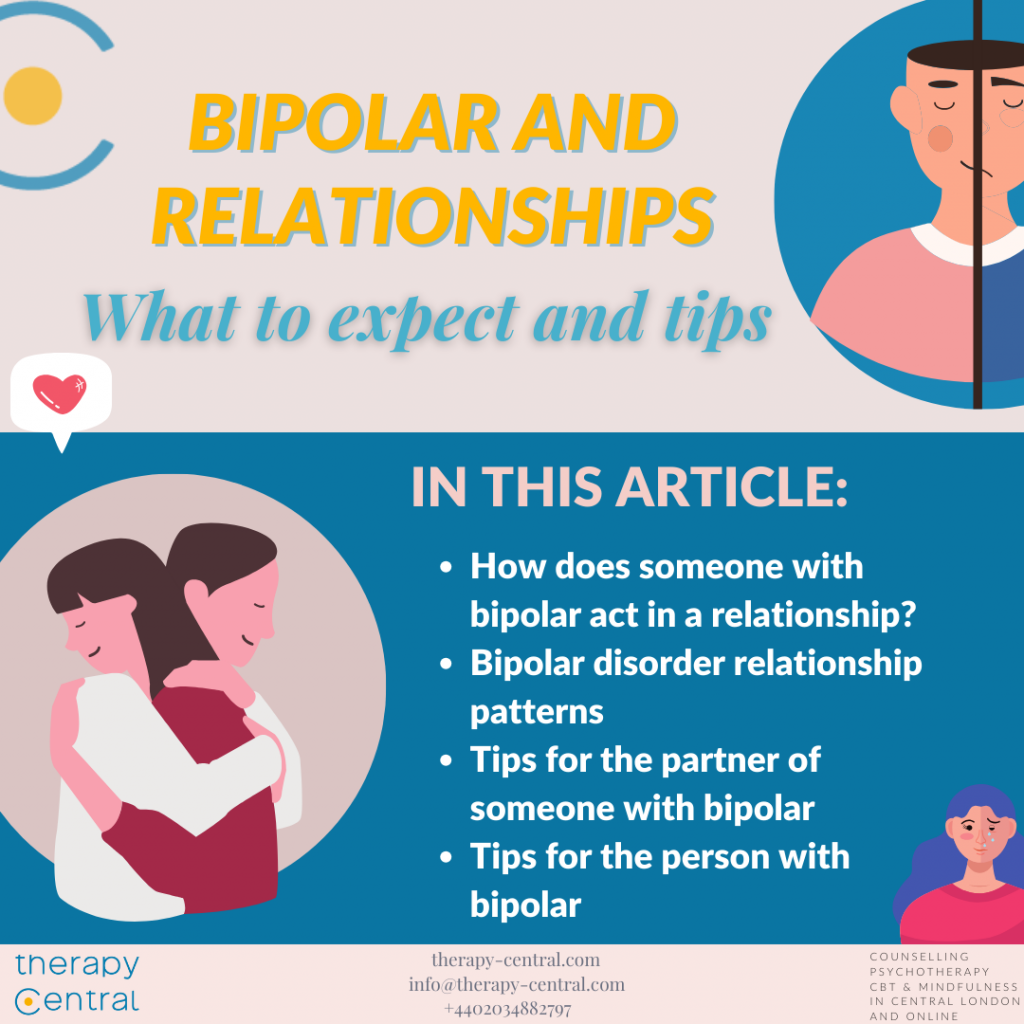Do you sometimes feel like your limits are being crossed by other people? Is it difficult for you to say “no” to your friends or refuse countless requests from your coworkers? Perhaps you struggle with built-up resentment towards your partner or family member? If so, chances are you might benefit from learning how to set healthy boundaries in your life. It’s a crucial skill that supports our wellbeing and makes our relationships fulfilling. In this post, we discuss the importance of boundary setting, the differences between healthy and unhealthy boundaries, and ways to set them with yourself and your loved ones.
What is Boundary Setting
We interact with other people every single day. In each of those relationships, whether it’s our partner, a coworker or a friend, we set boundaries. They act as fences, defining our personal space and keeping us safe. Some of us introduce rigid boundaries and others prefer to keep their boundaries loose. While different for all of us, healthy boundaries fall somewhere in between the two ends of this spectrum. Healthy boundaries simply state where one person ends and another begins.
Why Are Healthy Boundaries Important
Introducing and maintaining healthy boundaries can significantly benefit our mental and emotional wellbeing.
Firstly, they help us define our needs and expectations. That is why stating boundaries starts with recognising, understanding and respecting our values and priorities. That, in turn, boosts our self-esteem and strengthens our sense of autonomy.
Secondly, healthy boundaries make relationships less complicated. Both sides know what behaviour can be accepted and expected of each other. That mutual understanding brings us closer and decreases the risk of experiencing burnout, stress, anger or resentment.
Finally, healthy boundaries enable us to cultivate authenticity, bringing a sense of inner peace and balance to our lives.
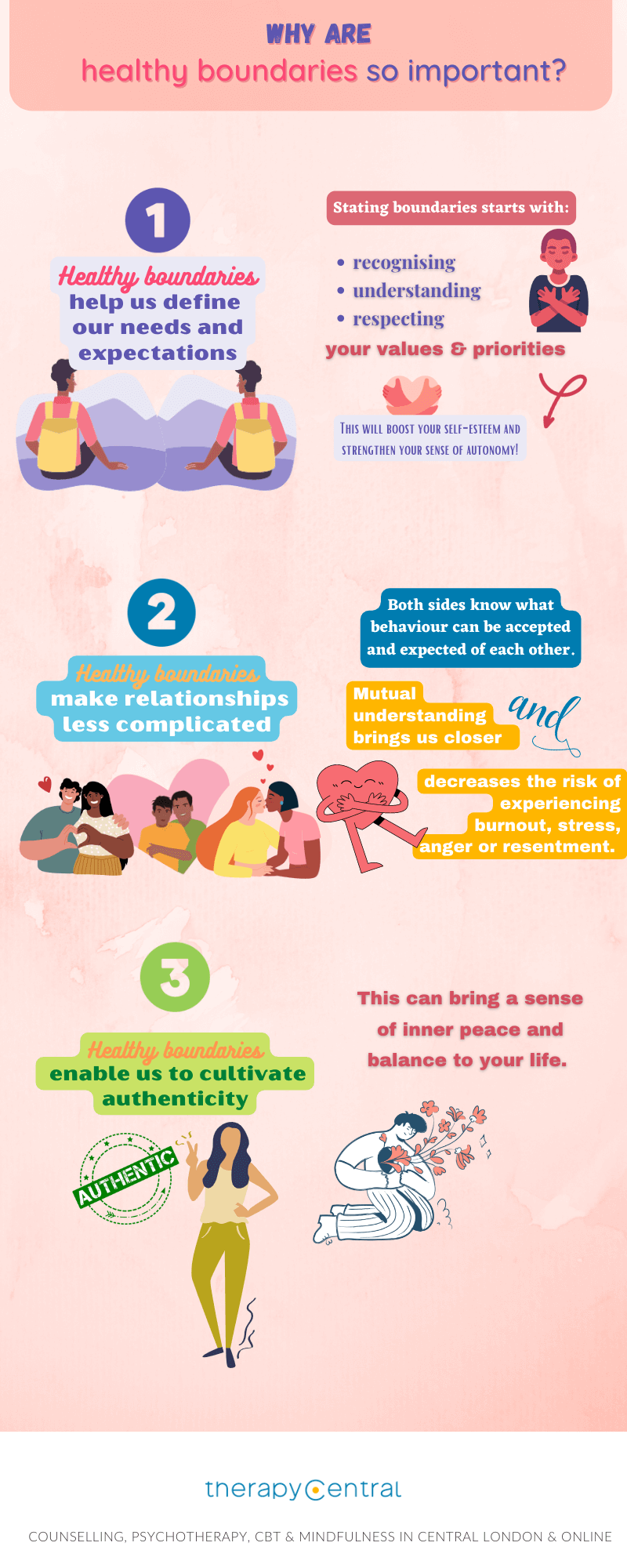
Share this Image On Your Site
Healthy vs Unhealthy Boundaries
Setting healthy boundaries is not a skill that we’re born with. Most of us don’t know how to do that intuitively. That’s why we sometimes end up in unfortunate, uncomfortable, or even abusive situations. In order to learn how to set healthy boundaries, a good first step is to understand how they differ from unhealthy ones.
There’s a good chance that the boundaries in your life are healthy, if:
- You understand your needs and communicate them to others
- You respect different opinions and beliefs of other people
- You can say “no” with assertiveness
- You disclose personal information in an appropriate setting

On the other hand, though, there are unhealthy boundaries which put our wellbeing at risk. You might struggle with them if you have trouble with:
- Clearly explaining your needs
- Accepting someone else’s refusal of your request
- Pleasing others by compromising your beliefs and values
- Dominating conversations
- Oversharing your personal information (on social media as well)
- Feeling fatigued, emotionally drained or anxious after meeting a particular person
When Unhealthy Boundaries Become Abusive
Unhealthy boundaries can become emotionally, sexually and physically abusive. You may have experienced abuse if:
- you were manipulated, gaslighted or excessively controlled by another person
- Your physical safety has been breached
- You’ve been forced to do something you didn’t want to do
In such cases, deciding to end such a relationship or clearly stating healthy boundaries is absolutely crucial.
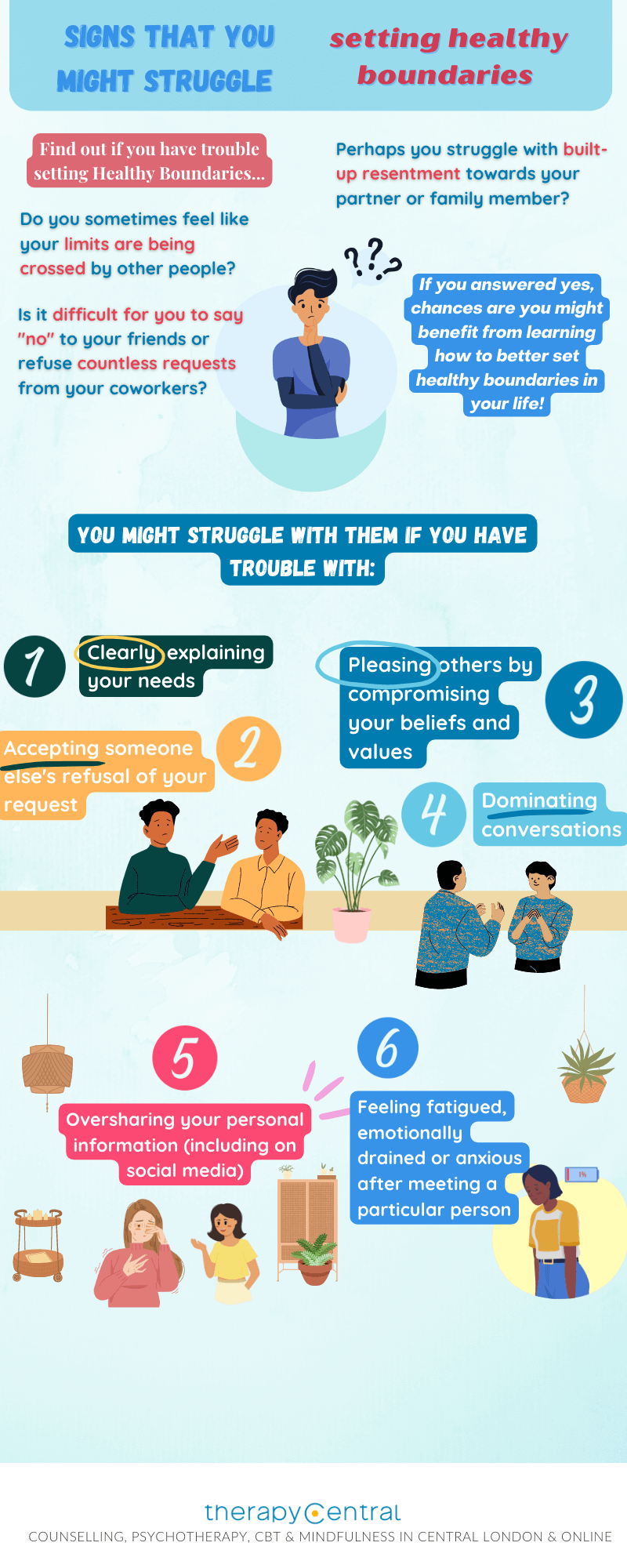
Share this Image On Your Site
Example of Healthy Boundaries
Healthy boundaries are often visible in seemingly small acts such as:
- Setting some time aside once a week to practice your hobby
- Not going out and partying a night before an important exam
- Stopping an argument with your partner when you’re heated up and taking some time to cool off
- Deciding not to discuss particular matters with family members
How To Set Healthy Boundaries: For Yourself
Before you set boundaries with other people, define them for yourself first. Carve out some time to sit in silence and clear your mind. Try to describe your top values and priorities as precisely as you can. Then see if you behave in accordance with them.
Let’s say you’d like to improve your sleeping habits, but each night you end up binge-watching Netflix. A healthy boundary would mean using self-discipline and going to bed earlier to achieve your goal.
How To Set Healthy Boundaries: In a Relationship
Healthy boundaries support mutual wellbeing in a relationship and decrease the risk of toxic behaviours between partners. When communicating your boundary, it’s good to keep these tips in mind:
- Pick an appropriate moment
- Avoid blaming your partner or exaggerating through the use of thinking errors
- Use “I” statements:
Instead of saying, “You always leave a mess in the kitchen.”
Try saying, “I feel frustrated when I see a mess in the kitchen made by you.”

How To Set Healthy Boundaries: With Family
Addressing issues with parents can be challenging, especially if you have a parent with mental health issue. Yet, avoiding confrontation can put you at a higher risk of suffering from depression.
So, before starting a possibly difficult conversation, remember:
- Treating your parents with respect will set the right tone.
- You are not here to engage in an argument.
- Less is more, so be clear and direct.
Let’s say your parent continuously judges your appearance, which is hurtful to you. In that case, you can say:
“I feel disrespected when you comment on my looks. I want to express myself freely without hearing your judgements about it.”
How To Set Healthy Boundaries: At Work
Did you know that a blurry boundary between work and private life is connected with decreased happiness, unhealthy lifestyle and an increased risk of a familial conflict? That’s why it’s so important to figure out how much time you can spend on work and when to stop it.
Let’s say your coworker just asked you for a favour. To refuse it, you can say:
“I don’t think I’m the right person for this project as I have a lot on my plate. Perhaps XYZ will be able to help you.”
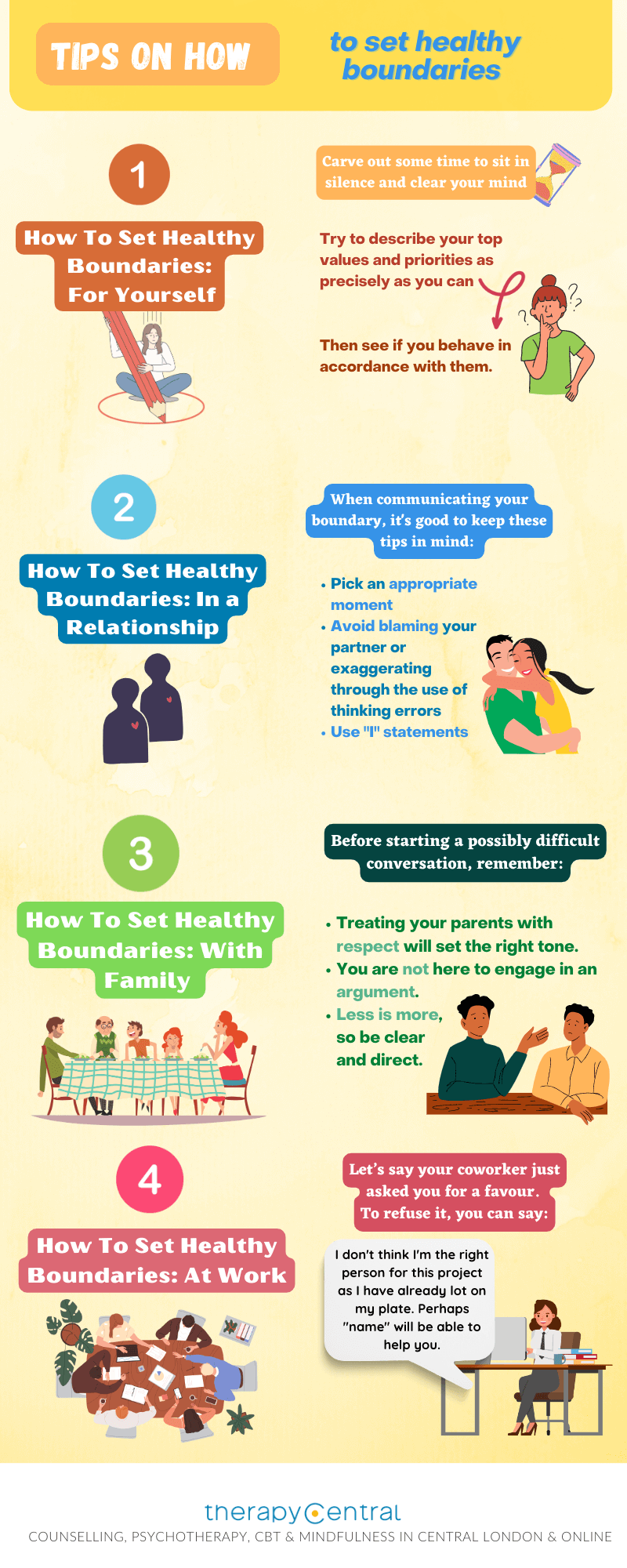
Learn How To Set Healthy Boundaries Today
Setting healthy boundaries is a difficult skill to develop and maintain. When neglected, it can negatively impact the quality of your life and prevent you from achieving your goals. Leaving with consistently unhealthy boundaries in work, personal relationship and with yourself can lead to issues with anxiety, depression, anger and relationship difficulties.
If you’d like to learn how to set healthy boundaries, get in touch with our qualified therapists who can assist you on the journey of taking care of your needs and priorities.
Contact us for a free 15-minute consultation today!
Read More:
Relationship Counselling in London and Online
Depression Counselling in London and Online
Assertiveness Training Therapy
Counselling for stress at work

